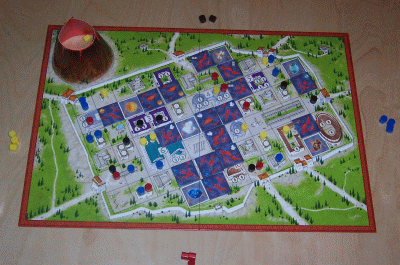Manufacturer : Amigo
Author : Klaus-Jürgen Wrede
Number of Players : 2-4 (3-4 ideal)
Age : 10 years plus
Time : about 45 mins.
Year: 2004
ENGLISH MAIN PAGE
 Deutsche Spielerezension
Deutsche Spielerezension
| Pompeji |
| General Information: Manufacturer : Amigo Author : Klaus-Jürgen Wrede Number of Players : 2-4 (3-4 ideal) Age : 10 years plus Time : about 45 mins. Year: 2004 ENGLISH MAIN PAGE  Deutsche Spielerezension Deutsche Spielerezension |
 |
| Game Components: 1 gameboard - 127 game pieces - 53 Pompeji cards - 7 cards "Omen" - 1 card "A.D. 79" - 1 volcano - 1 cloth bag - 45 lava tiles - 1 rulebook |
| Further
Information: - Homepage of Amigo - English rules for "Pompeji" |
| Tip: You want to make the play more difficult? No problem: In phase 2 just forbid all the playing pieces to change direction more than once. Try it! |
| Troudi says 9 out of
10 points: "Pompeji" just is a great game: Actually I am really astonished that it hasn't got any awards (that is Deutscher Spielepreis or Spiel des Jahres) so far but maybe the theme is a bit too - well indecent. Any way: The game is really easy to understand and can be explained within a few minutes. The game contains tactical elements because you should try - in phase 1 - to place your playing pieces in a good starting order for phase 2. In phase 2 players have to decide where to place the lava tiles and should try to find out what pieces should be moved in order to save as much own citizens as possible. Most important the game really is fun: You'll feel better once you thrown one of your opponent's citizens into the volcano and you'll get angry when that happens to you more than once. The game is not a language-specific game and you can easily download the rules (see the link). I really do recommend this game. It is suitable for all types of game interest and really is a interesting and very entertaining. Buy it or at least try it! The game costs about 22 Euros or 40 US-Dollars. |